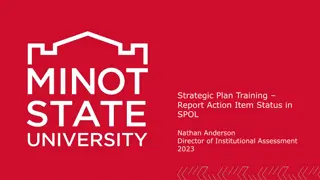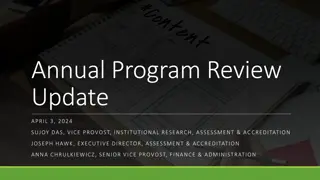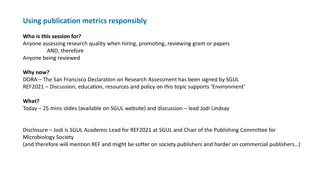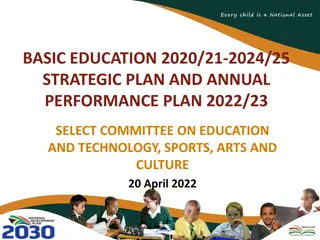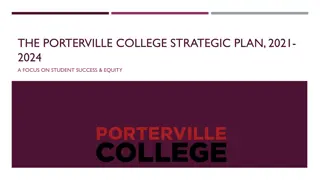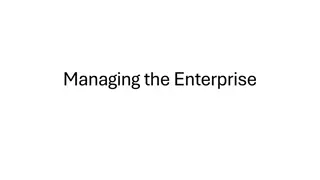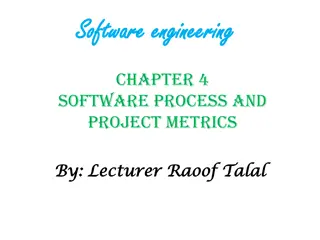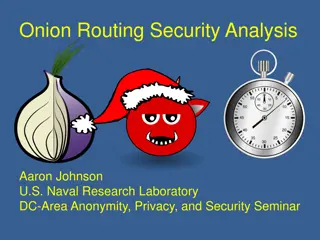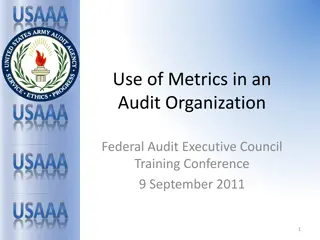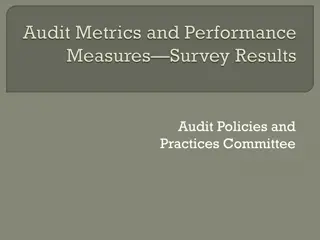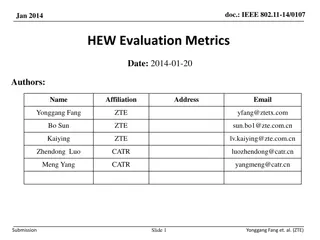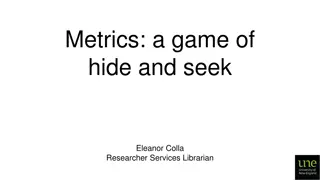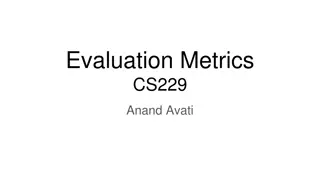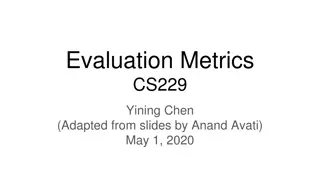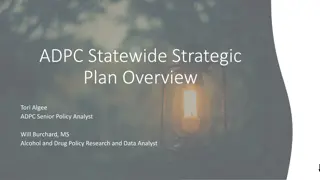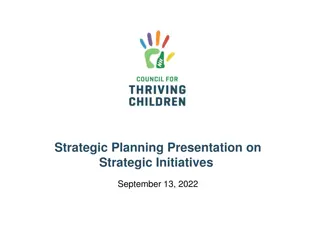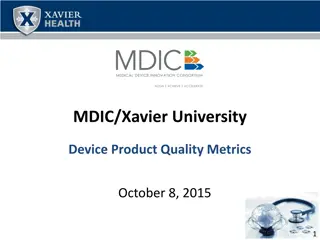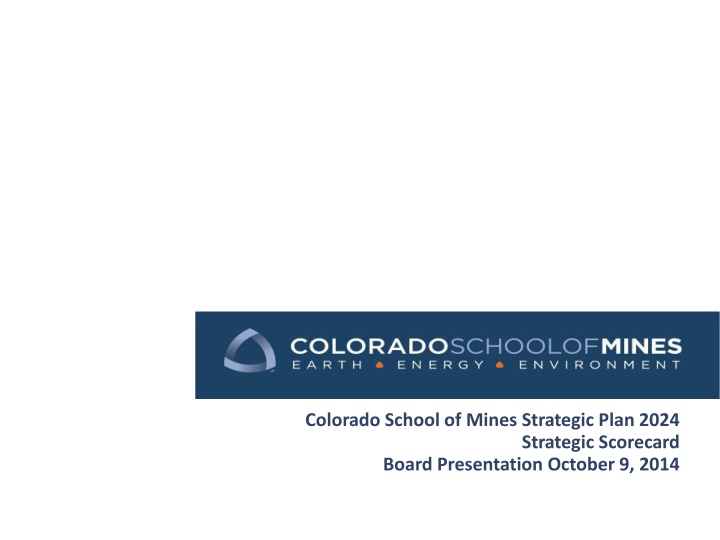
Colorado School of Mines Strategic Plan 2024 Scorecard Presentation
Explore the strategic scorecard presentation of Colorado School of Mines for their 2024 strategic plan. Dive into key metrics such as student outcomes, faculty information, research, fundraising, and student satisfaction, among others. Gain insights into targets and updates for various categories, including graduation rates, enrollment, and academic faculty.
Download Presentation

Please find below an Image/Link to download the presentation.
The content on the website is provided AS IS for your information and personal use only. It may not be sold, licensed, or shared on other websites without obtaining consent from the author. If you encounter any issues during the download, it is possible that the publisher has removed the file from their server.
You are allowed to download the files provided on this website for personal or commercial use, subject to the condition that they are used lawfully. All files are the property of their respective owners.
The content on the website is provided AS IS for your information and personal use only. It may not be sold, licensed, or shared on other websites without obtaining consent from the author.
E N D
Presentation Transcript
Colorado School of Mines Strategic Plan 2024 Strategic Scorecard Board Presentation October 9, 2014
2 Strategic Scorecard Measures Student Outcomes 4-Yr graduation rate (overall, underserved as defined by state in performance contracts) 6-Yr graduation rate (overall, underserved) Freshman retention (overall, underserved) BS degree outcomes rate Academic Faculty Headcount (Tenured / Tenure-track / Teaching) Faculty departures non-retirement Members of the National Academies of Engineering or Sciences Student to Faculty Ratio Degree-seeking enrollment/ Academic Faculty Common Data Set Student Selectivity % Freshman non-resident All Freshman ACT / SAT avg New PhD GRE median Research Expenditures Fundraising Total dollars raised Endowment National Survey of Student Engagement (NSSE) Results Experiences at institution contributed to: Improvement in communication skills Analytical skills and knowledge Understanding people of other backgrounds & being an informed and active citizen Student Satisfaction Financial ratios Debt service coverage Net asset to Debt Expendable Resources to Operations Strategic enterprises net revenues Enrollment Degree-seeking Undergraduate Graduate
3 Mines Strategic Scorecard Colorado? School? of? Mines? Strategic? Scorecard 5-Yr? Target (2018-19) 10-Yr? Target (2023-24) Metrics 2013? (Base) 2014? (Update) 1.? ? Six-year? graduation? rate a.? Overall b.? Underserved? Students 2.? ? Four-year? graduation? rate a.? Overall b.? Underserved? Students 69.7%? (F07? cohort) 63.0%? (F07? cohort) 75.5%? (F08? cohort) 75.3%? (F08? cohort) 78.0% 78.0% 85.0% 85.0% 44.1? %? (F09? cohort) 35.2%? (F09? cohort) 46.1? %? (F10? cohort) 36.5? %? (F10? cohort) 50.0% 50.0% 60.0% 60.0% 3.? ? Freshman? Retention a.? Overall b.? Underserved? Students 5.? ? BS? Degree? Outcomes? rate? -? ? 1? year? after? graduation 4.? ? Student? Selectivity a.? ? %? Freshman? Non-Resident b.? ? ACT? /? SAT? (avg) c.? ? PhD? GRE? scores? (median) 6.? ? NSSE? Survey:? ? Mines? experience? contributed? to? student's? improvement? in: a.? ? Communication? skills b.? ? Analytical? skills? &? knowledge c.? ? Understanding? people? of? other? backgrounds? &? being? an? informed? and? active? citizen 7.? ? NSSE? Survey:? Student? Satisfaction 92%? (F12? cohort) 91.8%? (F12? cohort) 94%? (F13? cohort) 91.3%? (F13? cohort) 95.0% 95.0% 95.0% 95.0% 98%? (AY? 11-12) Avail? Oct? 31 99.0% 99.0% 43.7% 30? /? 1325 161 41.8% 30? /? 1320 161 47% 49% 31? /? 1360 162 32? /? 1400 164 Score? range:? 1-Very? little,? 2-Some,? 3-Quite? a? bit,? 4-Very? much 2.77 3.43 2.20 >3.3 >3.5 >3.0 ? Score? range:? 1-Poor,? 2-Fair,? 3-Good,? 4-Excellent 3.35 >3.5
4 Mines Strategic Scorecard Colorado? School? of? Mines? Strategic? Scorecard 5-Yr? Target (2018-19) 10-Yr? Target (2023-24) Metrics 2013? (Base) 2014? (Update) 8.? Enrollment? -? Degree? seeking? (headcnt) a.? Undergraduate b.? Graduate? 9.? ? ? Academic? Faculty? (headcnt)? -? T/TT/Teach 5,468 4,199 1,269 262 5,673 4,383 1,290 280 TBD TBD TBD TBD TBD TBD 10.? ? Faculty? departures? (non-retirement) 7.0 Avail? Nov? 1 TBD TBD 11.? ? Members? of? National? Academies? of? Engineering? or? Sciences? on? Faculty 4 4 5 7 12.? ? Student? to? Faculty? Ratio a.? Enrollment? /? Academic? Faculty b.? Common? Data? Set? 20.9 16.0 20.3 TBD TBD TBD TBD Avail? Nov? 1 13.? ? Research? expenditures? ($) $56? MM $56.7? MM $75? MM $100? MM 14.? ? Fundraising a.? Total? dollars? raised b.? ? Endowment 15.? ? Financial? Ratios a.? ? Debt? Service? Coverage b.? ? Net? Asset? to? Debt c.? ? Expendable? Resources? to? Operations $35.4? MM? (FY13) $213? MM? (6/30/13) $271? MM? (6/30/14) $47.8? MM? (FY14) $40-45? MM $350? MM TBD $500? MM 3.27 1.60 1.09 3.14 2.11 1.33 >1.20* >1.08* >0.47* >1.20* >1.08* >0.47* *? minimum? standard? per? debt? policy. $5? MM 16.? ? Strategic? enterprises? net? revenue $0 $0 $10? MM
5 Graduation and Retention Rates Comparison of other STEM-based peers or aspirational peers: Freshman? Academic? Characteristics US? News? Rankings Student? Selectivity? Rank 20 22 36 28 50 NR 45 36 87 71 SAT? 25-75? percentile Overall? Ranking Retention 4yr? (%) 6? yr? (%) top10% top? 25% Berkeley Carnegie? Mellon RPI GA? Tech WPI Rose-Hulman Stevens? Institute Mines Michigan? Tech Rolla **All? data? from? USNews? Common? Data? Set Retention? is? 3? year? average? of? fall? 2009? -fall? 2012? cohort Graduation? rates? are? from? 2007? cohort Student? characteristics? are? from? fall? 2013? freshman? class 97 95 93 95 96 92 94 90 82 84 72 74 65 41 70 71 45 38 24 25 91 88 85 82 81 79 79 70 66 63 1250-1500 1340-1530 1290-1488 1290-1480 1220-1410 1220-1420* 1210-1390 1260-1420* 1110-1300* 1150-1380* 98 80 72 81 64 66 68 66 30 41 100 96 95 95 91 92 89 93 65 71 20 25 42 35 68 NR 76 88 116 138
6 BS Degree Outcomes 2012 - 2013 Annual Report A- 2 December 2011 - August 2012 B S Graduates Data source: Career Center Annual Report (Graduates Reported i n the 2011-2012 Annual R e p ort) Intl. Returning 3 Grad. School 5 % O t comes Government 2 Not Looking # of Double 2 # of Gradu- to C Contacted Contacted Unable to Students Students Seeking Industry Contact Military Majors o ates OPTION untry u Definition of Positive Outcome: Accepted a position within their field, or have chosen to attend graduate school. Chemical E n gineering 61 48 0 2 1 61 0 98% Chemical & Biochemical Engineering 41 0 30 0 0 9 1 1 0 41 0 100% Chemistry c 26 2 10 1 1 12 0 1 1 26 0 96% Computer S ience 37 3 27 0 0 8 0 1 1 37 0 97% Economics 14 3 9 0 0 3 1 1 0 14 0 100% Engineering -Civil 69 5 55 0 0 11 0 3 0 69 0 100% Engineering -Electrical 60 16 53 0 1 4 0 1 1 60 0 98% Engineering -Environmental 20 0 14 0 0 6 0 0 0 20 0 n n 100% Engineering -Mechanical 147 21 119 2 4 17 0 2 2 146 1 99% Geology & Geological E gineering 33 0 20 0 0 10 0 2 1 33 0 97% Graduates who have notified the Career Center that they are not looking are considered to be on their chosen career path and counted as a positive outcome. Geophysics & Geophysical E gineering 20 1 12 1 0 7 0 0 0 20 0 n 100% Mathematics 15 2 4 0 1 7 0 1 2 15 0 87% Metallurgical & Materials E gineering 33 0 22 1 0 7 0 3 0 33 0 n 100% Mining E Petroleum Engineering Physics - Engineering gineering 23 110 51 1 0 2 15 81 13 0 0 0 0 0 2 5 6 32 3 21 0 0 0 1 0 1 2 23 109 50 0 1 1 100% w 98% 96% Sub-Totals ( ith double majors) 58 760 532 7 9 149 29 19 12 731 TOTAL 29 507 7 9 146 29 18 12 728 3 98% Note: Sub-totals are not the sum of the individual students, due to the inclusion of double majors twice. Totals are the actual number of individuals who graduated in each category/column. % O ANNUAL REPORT TCOMES IN % O ONE YEAR LATER TCOMES CLASS U U 2010 - 2011 2009 - 2010 2008 - 2009 2007 - 2008 2006 - 2007 2005 - 2006 2004 - 2005 2003 - 2004 2002 - 2003 2001 - 2002 2000 - 2001 90% 85% 86% 94% 95% 90% 73% 68% 66% 68% 86% 95% 98% 98% 98% 99% 99% 96% 86% 84% 88% 96%
7 Student to Faculty Ratio Two proposed methods: (1) Common Data Set: Most commonly used ratio externally. Allows for peer comparison (2) Internally defined: Degree-seeking students headcount / Academic Faculty headcount. Academic faculty only includes permanent tenured, tenure-track and teaching faculty members. Could also include faculty who are on transitional retirement. Data on the next page shows totals with and without transitional faculty. Another data source is US Department of Education IPEDS database. IPEDS SFR definition has evolved over time. It currently now mirrors the Common Data Set definition. Common Data Set: Definition Students. Full-time UG = 12 credit hours or more. Full-time GR = 9 credit hours or more. Part-time is converted to FTE as 1/3rd # of part-time students. Faculty. Includes full-time and part-time faculty. Full-time is based on AAUP s definition of instructional faculty. Full-time does not need to be permanent . Part-time allows for anyone teaching a credit hour, and is converted to FTE as 1/3rd # of part-time faculty. Peer comparison relies on accuracy of each institutional inputs and interpretation of definitions. Faculty definition is broader than what we may consider academic faculty .
8 Student to Faculty Ratio Colorado? School? of? Mines? Student? and? Faculty? Data Fall? Semester Enrollment? -? degree? seeking Faculty? (T/TT/Teach? headcnt) Student:Faculty? (Internal) Faculty? (w/Transitional? counted? as? 0.5) 286.0 268.5 253.5 246.0 248.5 238.0 239.0 224.0 213.0 214.0 204.0 200.0 Student:Faculty? inc.l? transitional 19.8 20.4 21.3 Student:Faculty? (CDS) 16.0 16.0 2014 2013 2012 2011 2010 2009 2008 2007 2006 2005 2004 2003 5,673 5,468 5,405 5,219 4,931 4,690 4,333 4,151 3,979 3,849 3,581 3,409 280.0 262.0 247.0 241.0 242.0 234.0 235.0 218.0 207.0 204.0 194.0 189.0 20.3 20.9 21.9 21.7 20.4 20.0 18.4 19.0 19.2 18.9 18.5 18.0 21.2 17.0 19.8 16.0 19.7 15.0 18.1 14.0 18.5 13.5 18.7 14.0 18.0 14.0 17.6 14.7 17.0 14.7 **? Enrollment? data? is? headcount? of? degree-seeking? students? as? of? Fall? Semester? Census **? Transitional? faculty? are? those? faculty? who? have? retired? but? retain? title? and? remain? on? contract? for? teaching? and/or? research **? Student:Faculty? (Internal)? =? Degree-seeking? enrollment? /? Academic? Faculty **? CDS? is? Common? Data? Set **2014? faculty? data? is? estimated? until? November? 1st? census Student? to? Faculty? Ratio? Peer? Comparison? (Common? Data? Set) Fall? Semester Illinois? IT Michigan? Tech WPI RPI Mines NJIT Missouri? ST Georgia? Tech CU-Boulder 2013 2012 2011 2010 2009 2008 2007 2006 2005 2004 2003 13 13 12 12 11 13 14 15 17 16 17 17 10 13 14 16 16 15 17 19 10 15 14 16 15 15 16 20 9 8 8 na 11 na na 14 13 14 14 13 11 na na 13 11 na na 15 11 13 11.6 na na 14 12 14 14 16.2 13.8 15 16 17 17 17.47 13.9 15 16 16 17 17.7 18.8 14.1 14 14 14 15 14 18.1 13.7 13.5 13.5 15 14 15.8 14.7 13 na 14 17.5 14.7 13 na 14 17.5 18 18.7 18.7 18.3 16.4
9 NSEE Questions code of values and ethics Identified Improvement in knowledge, skills, and personal development b. Understanding people of other backgrounds (economic, racial, ethnic, political, religious, nationality, etc) How much has your experience at this institution contributed to your knowledge, skills, and personal development in the following areas? c. Being an informed and active citizen a. Communication skills Student Satisfaction a. Writing clearly and effectively How would you evaluate your entire educational experience? b. Speaking clearly and effectively c. Working effectively with others If you could start over again, would you go to the same institution you are now attending? b. Analytical skills & knowledge a. Thinking critically and analytically b. Acquiring job or work related knowledge and skills c. Solving complex, real-world problems c. Understanding people of other backgrounds & being an informed and active citizen a. Developing or clarifying a personal
Colorado School of Mines Strategic Plan 2024
11 Mission Education and research in engineering and science to solve the world s challenges related to the earth, energy and the environment Colorado School of Mines educates students and creates knowledge to address the needs and aspirations of the world s growing population. Mines embraces engineering, the sciences, and associated fields related to the discovery and recovery of the Earth s resources, the conversion of resources to materials and energy, development of advanced processes and products, fundamental knowledge and technologies that support the physical and biological sciences, and the economic, social and environmental systems necessary for a sustainable global society. Mines empowers, and holds accountable, its faculty, students, and staff to achieve excellence in its academic programs, its research, and in its application of knowledge for the development of technology.
12 Vision Mines will be the premier institution, based on the impact of its graduates and research programs, in engineering and science relating to the earth, energy and the environment Colorado School of Mines is a world-renowned institution that continually enhances its leadership in educational and research programs that serve constituencies throughout Colorado, the nation, and the world. Mines is widely acclaimed as an educational institution focused on stewardship of the earth, development of materials, overcoming the earth s energy challenges, and fostering environmentally sound and sustainable solutions.
13 Values A student-centered institution focused on education that promotes collaboration, integrity, perseverance, creativity, life-long learning, and a responsibility for developing a better world. The Mines student graduates with a strong sense of integrity, intellectual curiosity, demonstrated ability to get a job done in collaborative environments, passion to achieve goals, and an enhanced sense of responsibility to promote positive change in the world. Mines is committed to providing a quality experience for students, faculty, and staff through student programs, excellence in pedagogy and research, and an engaged and supportive campus community. Mines actively promotes ethical and responsible behaviors as a part of all aspects of campus life.
14 Guiding Principles As Mines implements this strategic plan, the following critical principles shall guide and inform decision-making throughout the process: Mines will remain a small, specialized engineering and science research university. We are proud of everything that we do. Emphasis on quality and excellence must be paramount in the education, research and services that we deliver The future distinction of the institution requires building multiple best-in-class programs at both undergraduate and graduate levels. Mines must operate with the entrepreneurial mindset of a private institution that promotes innovation in programs and cost efficiency in operations. Mines seeks to foster a diverse community with a sense of shared purpose toward serving our mission and our stakeholders. Mines will be recognized for its curricular delivery that is student-centered and leverages strengths of highly innovative faculty and best-in-class technology practices.
15 Aspirations When Mines celebrates its 150th anniversary in 2024, the success of the strategic vision and plan will be measured by having achieved or significant achievement towards these aspirations: Recognized in the top 10 among similarly-sized peer institutions (High-STEM) 4-year graduation rate of 60% and 6-year rate of 85% while still maintaining Mines hallmark commitment to quality, rigor and excellence Surpass $100M in research expenditures Mines will continue to be financially self-sustaining 95% of graduates (undergraduate and graduate) report that they would have chosen Mines again if they could re-do their decision
Goal 1: Enhance the distinctive identity and reputation of Mines 16 Strategies Develop and implement integrated marketing plan that expands our brand recognition and reputation throughout the world. Increase collaborations with other top quality institutions worldwide. Expand active-learning instruction (such as studio and project-based, rather than traditional lecture format) utilizing best-in-class pedagogical and technological practices. Improve and expand opportunities for participation in professional practice and research throughout the entire undergraduate experience. Expand and enhance graduate student development of professional attributes through formalized activities and curricular excellence. Create new and enhance existing large research initiatives focusing on the global challenges related to the earth, energy, and the environment. Increase faculty membership in national academies and professional society fellows, and student participation in prestigious national awards and fellowships.
Goal 2: Build upon a student-centered campus culture of excellence, inclusion, diversity and community. 17 Strategies Expand residential campus to integrate efforts from academic affairs and student life, for undergraduate and graduate students, to promote student community and to foster collaboration, learning, leadership and citizenship. Advance academic culture and structure that fosters creativity, intellectual-curiosity, and student success. Enhance opportunities for students to develop effective communication skills as a complement to strong content expertise. Build a campus that values employees and students of the institution through a positive, supportive, and inclusive environment. Increase the diversity and quality of Mines faculty, student and staff. Improve mentoring and other support of faculty with the goal to enhance the overall quality of the student experience.
18 Goal 3: Build and diversify revenue streams and auxiliary enterprises. Strategies Build upon advancements in board authorities that define our relationship with the state. Expand institutional support and infrastructure development through alumni outreach and Foundation initiatives. Establish new or expand continuing education and executive education enterprises that enhance the reputation, global reach, and financial security of Mines. Continuously investigate new technologies and market trends that threaten core revenues, and respond to best leading practices that maintain our preeminence in instructional delivery. Diversify federal research funding across multiple agencies while increasing corporate and private research support. Support research innovation through an enhanced technology transfer program.
Goal 4: Develop and support campus infrastructure and processes to match Mines' aspiration to become a top-tier engineering and science institution. 19 Strategies Incorporate within the overall financial plan a strategy to sustain and improve capital infrastructure. Produce, and continuously monitor the effectiveness of, faculty teaching and research guidelines that promote excellence and satisfaction. Align performance expectations, outcomes, rewards and recognitions with campus needs and the strategic plan. Assess and reconfigure administrative processes to promote institutional efficiency, communication, transparency and ease of access to information. Upgrade and enhance instructional infrastructure and support services. Enhance and expand research infrastructure to support growth in research while ensuring effectiveness and efficiency.

